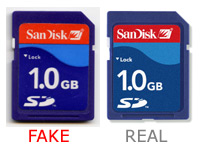We often hear people saying that "if it's cheap, it's inferior". Well, that may not apply for some services or products, but when it comes to memory media it is often the case. The fake ones are generally sold online or via unscrupulous retailers at half the price (or sometimes much less) of the real McCoys. So what difference will it make when using a bogus media?
For starters, counterfeit memory card wouldn't work as well as the real deal. The most distinct difference would be its performance. Write speed and transfer rate are slower, and storage capacity of the fake ones may even be lesser than indicated. There are reports of people buying a fake 2GB memory media, only to find out that it can hold just half its capacity.
Most flash media come with a warranty card in the packaging. If you've bought a fake media and it fails, there is no way the real manufacturer will replace it, even if its brand name is pasted on the card.
The failure rates for the imitations vary, but don't take the chance. The last thing you will want to happen is for the card to fail when you are in the middle of a holiday. Some of the fakers tend to get corrupted when formatted, or when read by card readers.
So how do we spot the tell-tale signs of a counterfeit?
Packaging
The fake card came with what appears to be genuine-looking packaging, as shown below.

The genuine SanDisk boxes have a hologram logo sticker on the front of the box, in the bottom left corner, just above the SanDisk logo, but this fake box is missing the sticker.
The "SanDisk Ultra" text on the genuine box is also much more embossed and glossy, and the "II" text to the right of the "Ultra" on the fake box doesn't line up with the rest of the text.

The protective cases for the cards are also different, with the case for the fake card being slightly smaller. The fake card didn't actually fit into its protective case properly, as the case appeared to be slightly too small.

 Most of the time, the packaging will give it away. Fake memory media normally comes in shabby-looking boxes. Established brands like SanDisk and Sony will have a hologram sticker on the box stating its genuine origin, while fake memory media often comes in an inferior-quality box and doesn't display a hologram sticker. Some stores will even attempt to sell the frauds as it is without the box, at a much lower price.
Most of the time, the packaging will give it away. Fake memory media normally comes in shabby-looking boxes. Established brands like SanDisk and Sony will have a hologram sticker on the box stating its genuine origin, while fake memory media often comes in an inferior-quality box and doesn't display a hologram sticker. Some stores will even attempt to sell the frauds as it is without the box, at a much lower price.
Labels


Note the faded red print on the back, and the "TM" next to "CF" at the top right side on the fake.

Note there is no serial on the bottom of the fake (serial blurred on the real one).
Look at the card carefully for its serial number. Chances are that if it is the real deal, the media will have a serial number on it. Frauds will often bypass this process and produce cards that don't carry any serial number. Note that the wordings on fakes may be printed wrongly. There are reports on the Web where people have bought cards from "Sorry Corporation". Go figure.
Dimension
 Since the pirates don't have the exact same mould that the original manufacturers have, the cards that they roll out often have missing notches or catches. These media may not sit in the memory slot properly (due to size and design) and could thus hinder operation.
Since the pirates don't have the exact same mould that the original manufacturers have, the cards that they roll out often have missing notches or catches. These media may not sit in the memory slot properly (due to size and design) and could thus hinder operation.
For all the potential memory card buyers in Malaysia and around the world, Micron and Intel recently has announced a new type NAND flash called TLC (triple-level cell) chips. The downside of TLC NAND Flash is that the performance isn’t as good as SLC or MLC as it takes longer to write three bits compared to one or two. On top of that, as more data is store per cell, the longevity won’t be as good.
Many manufacturer from China has started using this TLC chips to produced mass-market OEM or fake memory cards and the unscrupulous resellers are making profits out of it by positioning its pricing, same or equivalent to the MLC or SLC memory cards.
Sources: TLC NAND Flash, Fake Memory Cards






No comments:
Post a Comment